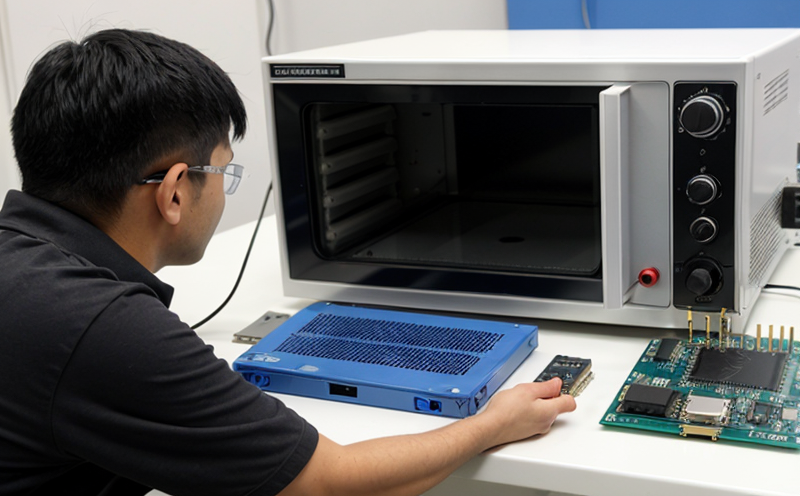EN 60749 Mechanical Shock Testing for Semiconductor Devices
The EN 60749 mechanical shock test is a crucial procedure used to evaluate the structural integrity and reliability of semiconductor devices under rapid, forceful impacts. This test is particularly important in sectors where components are exposed to harsh environments or subjected to mechanical stress during manufacturing, transportation, or use.
The standard EN 60749 specifies procedures for determining the resistance of electrical equipment to mechanical shock. The test involves subjecting semiconductor devices to a controlled impact force from above, which simulates real-world conditions such as dropping, bumping, and vibration. This ensures that the device can withstand potential damage without compromising its functionality.
During the EN 60749 test, specimens are typically placed on a rigid surface, aligned to simulate their orientation in use or during transport. The testing apparatus then applies an impact force according to predefined parameters specified in the standard. The force is delivered in a controlled manner, ensuring consistent and repeatable results.
The specimen preparation involves cleaning the device thoroughly to remove any contaminants that could affect the test outcome. The orientation of the device is carefully considered; for example, sensitive components may need to be oriented in a specific direction to ensure accurate testing. After preparation, the device is placed into the test fixture and secured.
The impact force is measured using high-precision sensors, ensuring accuracy in replicating real-world conditions. The duration of the impact and its energy are carefully controlled to match the specified parameters. This allows for a detailed evaluation of how the semiconductor device responds under mechanical stress.
The test results are analyzed based on predefined acceptance criteria outlined in EN 60749. These criteria include visual inspection, electrical continuity checks, and performance tests. Devices that pass these checks indicate that they can withstand the specified levels of mechanical shock without failure.
In industries such as automotive, aerospace, and consumer electronics, where reliability is paramount, this test ensures that semiconductor devices meet stringent quality standards. By adhering to EN 60749, manufacturers can demonstrate compliance with international standards and provide confidence in the durability of their products.
| Parameter | Description |
|---|---|
| Impact Force | The force applied during the test, measured in Newtons. |
| Duration of Impact | The time it takes for the impact to occur, typically milliseconds. |
| Repetitions | The number of times the test is conducted on each specimen. |
| Orientation | The specific positioning of the semiconductor device during testing. |
Industry Applications
The EN 60749 mechanical shock test finds applications across various industries where semiconductor devices are exposed to mechanical stress. These include:
- Aerospace and Defense: Components in satellites, aircraft electronics, and military hardware need to withstand harsh environmental conditions.
- Automotive Electronics: Electronic control units (ECUs) must be robust enough to handle vibrations and shocks during vehicle operation.
- Consumer Electronics: Devices like smartphones, tablets, and wearables benefit from ensuring that their components can endure drops or bumps without failing.
Why Choose This Test
The EN 60749 mechanical shock test is essential for several reasons. Firstly, it helps manufacturers identify potential weaknesses in their products before they reach the market. By subjecting devices to controlled mechanical shocks, issues such as cracks or component detachment can be detected early on.
Secondly, this testing ensures compliance with international standards and regulations, which is crucial for export markets that require certification. For example, many countries mandate adherence to EN 60749 when importing electrical equipment.
Additionally, the test provides valuable data for R&D teams. By understanding how devices behave under mechanical stress, engineers can improve design iterations and enhance product durability.
Finally, customers benefit from products that have undergone rigorous testing. This instills confidence in consumers about the reliability of the products they purchase, which is particularly important for high-value items like automotive electronics or medical devices.
International Acceptance and Recognition
The EN 60749 standard has been widely recognized and accepted across various international markets. It is part of the broader family of standards that form the backbone of global electrical equipment safety regulations.
In countries like the United States, where compliance with international standards is important for importers, EN 60749 provides a benchmark for ensuring product reliability. Similarly, in Europe and Asia, adherence to this standard can facilitate smoother trade processes.
Many organizations, including regulatory bodies and industry associations, recommend or require the use of EN 60749 as part of their certification programs. This recognition underscores its importance in maintaining high-quality standards for electrical equipment worldwide.





